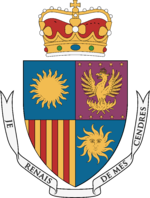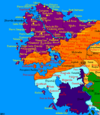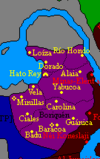Administrative divisions of Nouvelle Alexandrie: Difference between revisions
No edit summary |
|||
| Line 161: | Line 161: | ||
[[Category:Geography of Nouvelle Alexandrie]] | [[Category:Geography of Nouvelle Alexandrie]] | ||
[[Category:Politics of Nouvelle Alexandrie]] | [[Category:Politics of Nouvelle Alexandrie]] | ||
[[Category:Regions of Nouvelle Alexandrie]] | |||
Latest revision as of 18:21, 2 June 2023

|
This article or section is a work in progress. The information below may be incomplete, outdated, or subject to change. |
The administrative divisions of Nouvelle Alexandrie are the institutional and territorial organizational units of the territory that forms the Federation of Nouvelle Alexandrie, formerly known as Alduria-Wechua. The territory of the Federation is located on two continents: Eura and Keltia.
There are several administrative divisions, which may have political (local government), electoral (districts), or administrative (decentralized services of the state) objectives. All the inhabited territories are represented in the Federal Constituent Assembly.
Divisions
The Federation of Nouvelle Alexandrie is subdivided territorially as follows:
- Regions - top-level territorial subdivision, holds governmental jurisdiction over a separate and defined geographic territory. Shares its sovereignty with the federal government;
- States - second-level territorial subdivision, regions are subdivided into states. Consists of a geographic region with specific boundaries and usually some level of governmental authority. Specific governmental powers of states vary widely between the Regions;
- Special Cities - third-level territorial subdivision, granted to sizeable conurbations and important manufacturing centers. Specific governmental powers of the Special Cities vary widely between the Regions. A Special City obtains direct federal subsidies for the development of a healthy and sustainable economy and for New Prosperity Plan infrastructure projects;
- Outremer - a category for unincorporated territories under the control of Nouvelle Alexandrie for any special commercial or military purposes; they usually do not have sizeable or significant civilian populations.
Federalism in Nouvelle Alexandrie is the constitutional division of power between the federal government and local governments (regions, states, and special cities). The federal government, the regions, the states, the special cities, and municipalities have different tasks and partially competing regions of responsibilities ruled by a complex system of checks and balances.
The Proclamation of Punta Santiago serves as the founding document of the Federation and as its Constitution. It is in this document that a relationship of parity between the two levels of government, the federal and the local, is established.
As time has passed, the Federal Constituent Assembly, the Cortes Federales and the early governments of the Federation have taken a philosophy of devolution or the transfer of certain powers from the federal government to the Regions, typically involving the federal government providing block grants to the regions or the states directly to achieve a goal or an established program or commitment. The federal government then monitors outcomes but provides broad discretion to the regions and states for how the programs are implemented.
In the model of shared sovereignty, New Alexandrians are citizens both of the Federation and of the Region in which they reside. Regional citizenship and residency are flexible and no government approval is required to move between regions or states. Known exceptions to this are mainly for those persons restricted by certain types of court orders (such as paroled convicts and children of divorced spouses who are sharing custody). Regional governments are allocated power by the people (of each respective Region) through their individual constitutions or constituent charters. All are grounded in basic democratic principles, and each provides for a government, consisting of three branches, each with separate and independent powers: executive, legislative, and judicial. Regions are divided into states, which may be assigned some local governmental authority but are not sovereign. The structure of a state varies widely by Region and Regions also can create other local governments or special districts.
Regions (12)
States (51)
- Alduria:
- Alcalá
- Aldurian Capital District
- Altus
- Asuara
- Biscarrosse
- Carrillo
- Compostela
- Mondego
- Murcia
- Napoléon
- Nouradin
- Saint Ignace
- Rothborne
- Valoria
- Valenciana
- Valladares
- Villalba
- Baatharzi Autonomous State
- Ladino Autonomous State
- Wechua Nation:
- Antisuyu
- Chinchasuyu
- Kuntisuyu
- Qullasuyu
- Wechua Capital District
- Special State of Roanne
- Santander
- País Real
- Zanhuesa
- Costa Plata
- Esparraguera
- Cherusken
- Valencia
- Chambery
- Mayenne
- Lesve
- New Franciscania
- Cardozo & Malonton
- Isles of Caputia
- Gotfriedland
- Salzstein
- Ulrichtstadt
- Tablot
- New Luthoria
- Pharos
- New Luthorian Skerry
- Chiron & Ciricia
- North Lyrica
- Vinveil
- Clergues
- Belgeux
- Fauqier
- Santa Juana
- Gennesart
- Bougny
- Isla de Stormark
- South Lyrica
- Mailly
- Vitroluire
- Perpimans
- Toucourt
- Píaz Rosa
- Islas de Lyrica
- Islas de la Libertad
- Nuevo Corcovado
- San Lorenzo
- Píaz de Howard
- Dorado
- Estefanía
- Rincón
Special Cities (36)
Outremer
The Outremer territories are areas controlled by the government of Alduria-Wechua that are not considered "incorporated" for the purposes of federal law. Under the Proclamation of Punta Santiago, the King may issue Letters of Official Settlement to establish new Alduro-Wechua territory. This territory is established as "unincorporated territory" under the direct rule of the King or to another legally incorporated body "on behalf of the King". In the absence of an organic law (a lawful regional, state, or local constitution or charter) approved by the federal legislature, a territory is classified as unorganized. Selected constitutional provisions apply, depending on legislative acts and judicial rulings according to Alduro-Wechua constitutional practice, local tradition, and law.
There is currently 1 unincorporated territory, Ijubicastagrad Harbor.


































